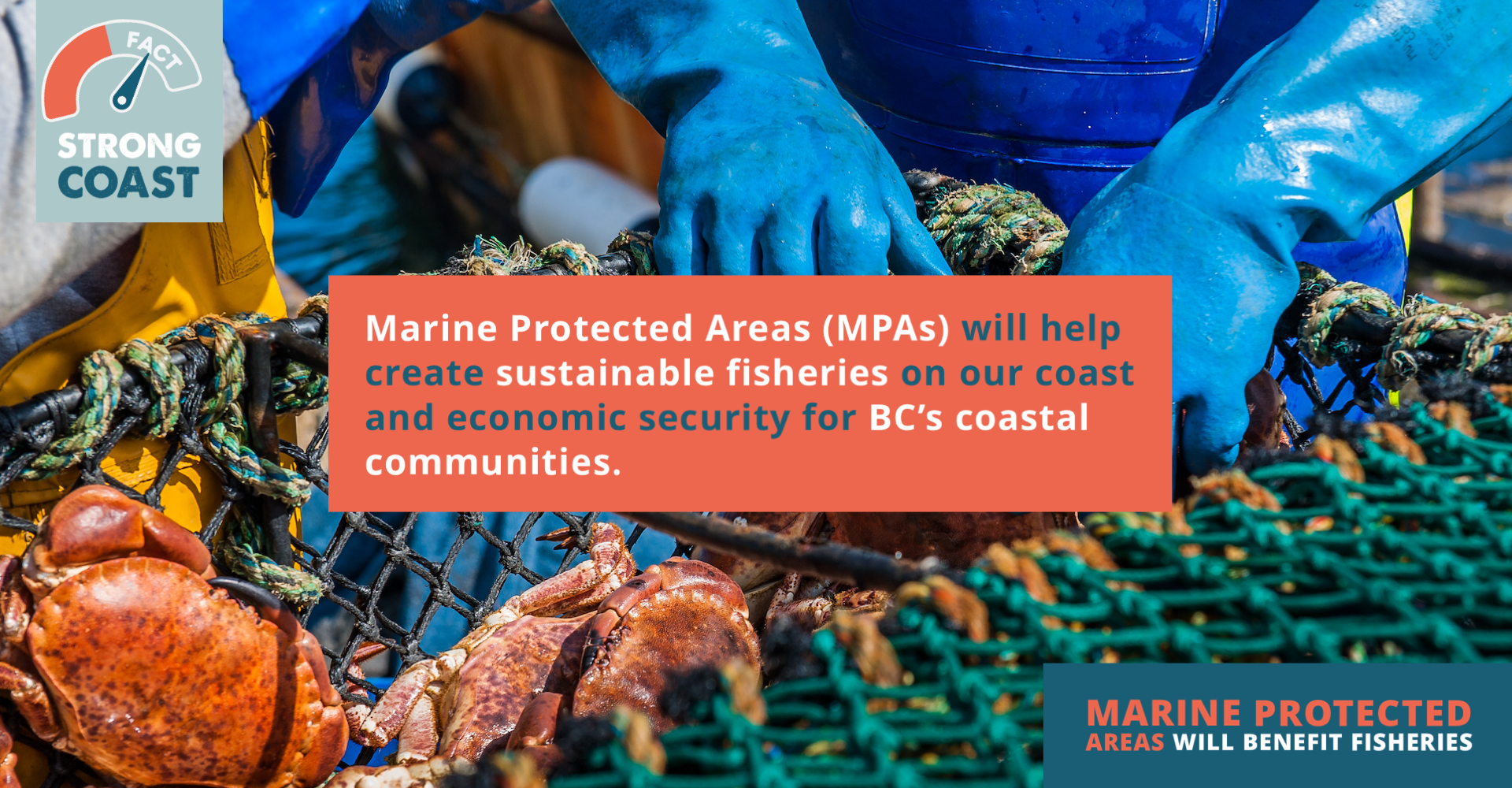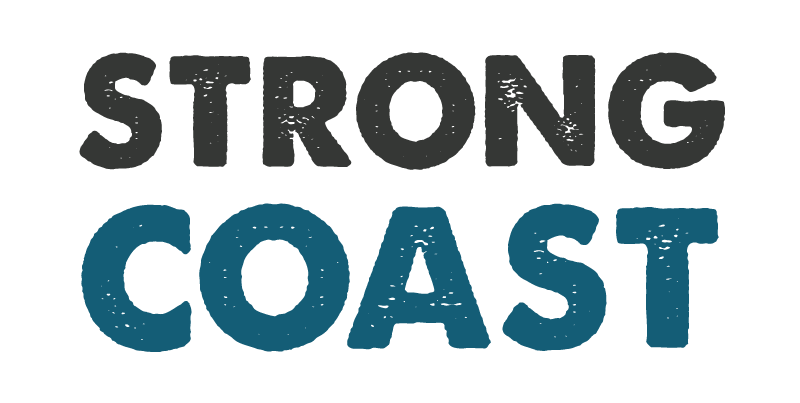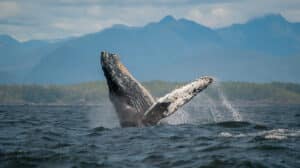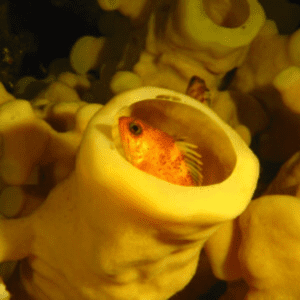
Food and economic security on our coast are under threat from overfishing and other destructive fishing practices, such as bottom trawling. These threats jeopardize marine environments crucial for providing food and livelihoods to communities. Overfishing has significantly depleted fish stocks, compromising our ability to sustain our marine food sources.
For instance, central coast chum salmon populations have declined by 90% between 1960 and 2020. Meanwhile, the 2022 herring season only saw a total catch weight of 4,000 tons, which was only about half the quota set by the DFO. These are just some examples of keystone species in BC that are facing significant threats to their population.
Marine Protected Areas (MPAs) have emerged as a crucial tool for sustainable ocean management, offering a balance between conservation needs and the economic realities of fisheries. Amidst the growing concerns about overfishing and marine habitat degradation, MPAs present a science-backed solution that promises not only to protect marine biodiversity but also to enhance the productivity and sustainability of fisheries.
The federal government, the Province, and Coastal First Nations in consultation with coastal communities and local fishers have developed a plan for the Great Bear Sea Marine Protected Area Network. This FAQ explores how the Great Bear Sea Marine Protected Area Network will benefit commercial fisheries in BC, looking into their impact on fishing yields, economic benefits, and the mechanisms through which they contribute to a healthier marine environment.
1. What will happen to fisheries with the establishment of the Great Bear Sea Marine Protected Area Network?
At least 85% of the Great Bear Sea will remain open to commercial fishing after the implementation of the Great Bear Sea Marine Protected Area Network, which will cover only about 30% of the Great Bear Sea. At most, only half of the Great Bear Sea MPA Network will be closed to activities like commercial fishing, aquaculture, and industrial practices like bottom trawling, oil and gas exploration and development, dumping, and undersea mining, which have proven to result in fish stock collapses, ecosystem decimation, and other harms to our coastal environment.
Any other restrictions within the Marine Protected Area Network will be determined on a case-by-case basis through consultation with local communities, governments, and scientists. For example, an MPA that was created to protect critical sponge reef habitats, which host a diverse variety of keystone species like salmon and herring, will have restrictions on the use of bottom-contact gear but may still permit seine or gillnet fisheries in the water column above the reef.
2. How will catch rates, volumes, and quality be impacted by the implementation of marine protected areas?
Well-designed marine protected areas can significantly contribute to the economic productivity of fisheries.
One of the primary ways that marine protected areas can benefit fisheries is via the “spillover effect.” Genetic and tagging studies have observed a buildup of juveniles and adults within an MPA, causing fish to swim beyond protected borders where they become available for fisheries. This is what is referred to as “spillover”. Spillover in the form of larvae or eggs, is also known to occur, whereby MPAs act as larval sources for overexploited populations and areas.
Because of spillover, various studies have observed marine protected areas can increase fish abundance, generate larger body sizes, allow species to live longer, and generate more offspring yield through the improved ability of female fish to produce eggs. A large global study found that fished areas around highly protected marine reserves experienced a fourfold average increase in catch rates. In fact, the spillover effect from MPAs can also benefit migratory species of high commercial value, and not just residential species.
Here are some other key examples:
Marine Protected Areas in the Pacific
The Revillagigedo National Park in Mexico is the largest fully protected marine protected area in North America. The fishing sector had been strongly opposed to its establishment, claiming that the MPA would result in a loss of up to 20% of their catches. However, a study conducted five years after the establishment of the MPA found no decrease in catches.
Two of the largest protected areas in the world are in Hawai’i (the Papahanaumokuakea Marine National Monument and the Pacific Remote Islands Marine National Monument). A 2020 study observed increased catch and catch-per-unit-effort since the expansion of both parks began.
In California, marine protected areas resulted in a 35% reduction in fishing area. Yet, the region saw a 225% increase in total catch of spiny lobster after a period of only six years.
Marine Protected Areas in Europe
Similarly, in Spain, researchers observed a mean annual net gain of 10% in lobster catch (in terms of weight) over an eight to 17 year period, again, despite a reduction in total area of fishing grounds in the marine protected area.
One study of 25 marine protected areas throughout the Mediterranean found that revenue for small-scale fisheries generally increased following the establishment of MPAs nearby. One MPA in Italy led to a 128% increase in fishermen revenues when they operated within MPA buffer zones compared to fishing outside the MPA. A buffer zone refers to the area surrounding an MPA where certain activities may be regulated or restricted to help enhance conservation efforts within the MPA. Some commercial activity may be permitted in a buffer zone, specifically small-sclae fisheries. In the case of this Italian MPA, spillover of fish populations from the MPA into the buffer zone greatly benefited local fishers.
While stakeholder concerns warrant careful consideration, there are abundant studies that have found the long-term benefits for fisheries significantly outweigh the initial costs. In cases where fishing areas are lost from spatial closures of marine protected areas, income from fishing can equal and even surpass pre-designation income in just five years.
3. Why does BC need Marine Protected Areas?
A lack of management is the true threat to the longevity of fisheries. In the early 1990s, following decades of lackluster intervention and poor management, the cod fishery in Atlantic Canada collapsed entirely. Due to a growth in the number of trawlers on the Atlantic coast, the cod catch peaked at 810,000 tons in 1968, three times more than the maximum yearly catch before the advent of trawlers.
But even after the government responded by banning foreign trawlers, they still overestimated the total supply and did not limit the total allowable catch enough. Canadian and American trawlers simply took the place of foreign trawlers, and soon enough, the industry collapsed completely.
Approximately 37,000 fishermen and fish plant workers across 400 Atlantic coastal communities lost their jobs in the blink of an eye. The federal government had to expend millions in economic assistance to these groups.
This is what the Great Bear Sea Marine Protected Area Network is trying to prevent from happening in BC. By providing a refuge where fish can grow larger, live longer, and produce more offspring, MPAs can help in the recovery of overexploited populations including salmon, rockfish, trout, herring species, and more, thus enhancing the viability and longevity of associated fisheries.
The purpose of the Great Bear Sea Marine Protected Area Network is not to achieve its goals at the expense of the marine economy. In fact, the raison d’etre of the MPA Network revolves around the marine economy.
Marine Protected Areas Will Benefit Fisheries
Marine protected areas can shape the future of fisheries and marine conservation for the better. By fostering the replenishment of fish stocks and protecting marine biodiversity, MPAs not only safeguard the environment but also bolster the economic sustainability of fisheries. The evidence presented underscores the potential of MPAs to enhance fishery yields, create economic opportunities, and contribute to a more resilient marine ecosystem. As the world grapples with the challenges of marine conservation, a sustainable economy, and food security, the strategic implementation of MPAs offers a path forward that harmonizes ecological health with human prosperity.




